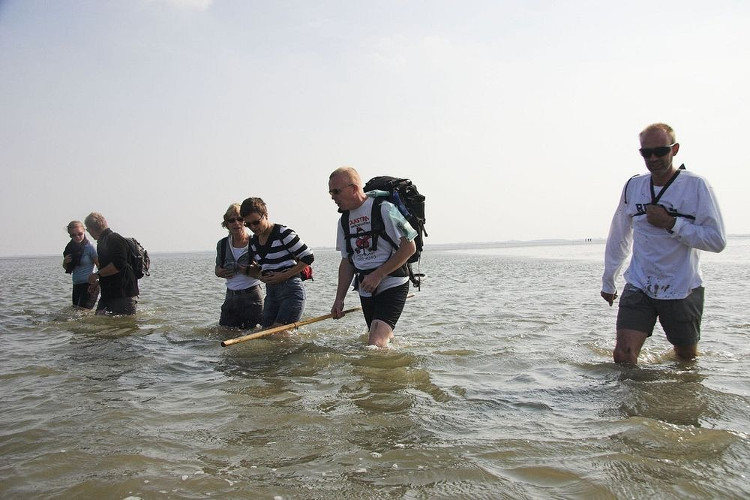The sea disappears twice a day
Visitors can walk barefoot in the Wadden Sea when the sprint reveals exposed slopes and large swamps.
The southeast coast of the North Sea, bordering Denmark and the Netherlands, is a mud belt and island. Normally this place is flooded with sea water, but twice a day the tide runs out, exposing 15km of large mud platform. The area is famous for the Wadden Sea name and is described as "one of the last intertidal (up and down) tidal ecosystems in the world".

Visitors experience "walking" on the Wadden Sea when the water is receding.(Photo: Flickr).
The Wadden Sea stretches from Den Helder in northwestern Netherlands through large German estuaries to the northern boundary at North Skallingen in Esbjerg, Denmark. The total length of the sea is about 500km on an area of about 10,000 square kilometers. In 2009, the German and Dutch Wadden Sea was listed by UNESCO as a World Heritage List and expanded to include Denmark in 2014.
A favorite hobby of the Dutch and the Germans is walking on the mud beds in Wadden as the sea recedes. This activity is called wattwandern in German and wadlopen in Dutch.
Wattwandern riders often leave their feet bare, allowing mud to cover their fingers and massage their feet naturally when walking at Wadden. The shellfish, clams and worms wiggle under their feet and the shrimps, small crabs, snails and starfish run aground because the sea water recedes lower than the ankles.
Visitors walk and learn about the ecosystem in Wadden.(Video: DW English).
Each year about 10,000 visitors to the Wadden Sea walk through the mud beds to reach some of the islands. These islands rise higher and are drier when the tide recedes. This walk is very dangerous because the mud can sink any time. There are marked roads and visitors need to follow directions to not deviate from the road.
Wadden Sea is rich in biodiversity. There are more than 10,000 species of plants and animals living together, from microorganisms to fish, birds and mammals. Many fish choose the Wadden Sea as a place to give birth, make use of shallow mudflats as a breeding ground for children. When they grow and mature they can migrate to the North Sea.
The Wadden Sea is also rich in food thanks to tides, attracting large numbers of birds such as geese, ducks, gulls, terns and seals. More than 30,000 seals live in the Wadden Sea, looking for food when the sea is flooded and "sunbathing" at low tide.

Their creatures and drives were exposed after seawater receded.(Photo: Flickr).
However, the biodiversity of the Wadden Sea today is very vulnerable to human-caused environmental pollution. Many fish such as Atlantic salmon, brown salmon, sturgeon, stingray, snails and oysters used to be found here are disappearing. North Atlantic whales and gray whales are no longer due to overfishing. The area of the Wadden Sea also decreases over time and has been reduced by 50% from its original size.
- This bat always disappears every winter and this is the cause
- What happens if the Earth's atmosphere disappears?
- Moon dives looking from outer space
- NASA's 'powerful arm' alien hunting disappeared mysteriously
- Video: Scenes on Earth if the Sun disappears
- What if the Earth disappears?
- About 2,000 uncommon languages can disappear from Earth within 100 years!
- Theory: Time can become a dimension of space!
- WWF: Global warming is hurting Europe
- Why snakes do not have legs?
- What will happen if you no longer see sunlight?
- Video: What will happen if the sun is gone?
 Is the magnetic North Pole shift dangerous to humanity?
Is the magnetic North Pole shift dangerous to humanity? Washington legalizes the recycling of human bodies into fertilizer
Washington legalizes the recycling of human bodies into fertilizer Lightning stone - the mysterious guest
Lightning stone - the mysterious guest Stunned by the mysterious sunset, strange appearance
Stunned by the mysterious sunset, strange appearance